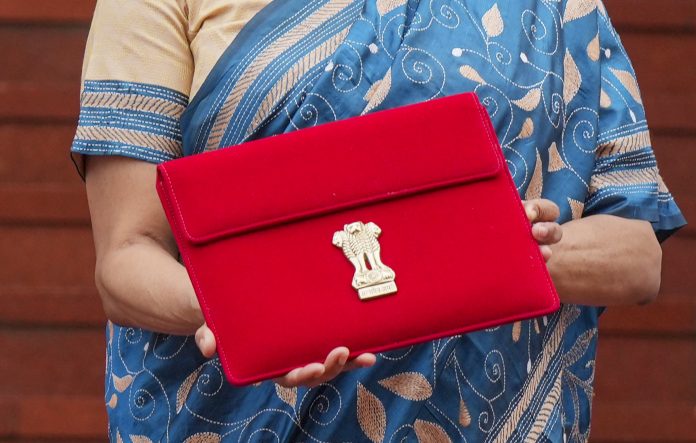Anjan Roy
Nirmala Sitharaman’s budget presented to Parliament on July 23 is a deeply political statement post the polls, containing though sound economic logic as well. As it is by now amply clear to the public, the Union finance minister, has laid out a development budget for Bihar and partly for Andhra Pradesh, while incidentally she presented as the union budget for the 2024-25 as well.
Underlying the budget is a political statement of the government, taking into account the electoral outcomes of the recent Lok Sabha polls. The general budget is, at the same time, based on common sense and is macro-economically sound, leaving untouched the present fiscal structure and tax regime by and large in tact. It does not have any great glamour or surprises, rather dull, but is rather solid
There are a few redeeming features of this budget which need to be taken note of. These are: First, sound fiscal situation. Given the ample fiscal buoyancy provided by the healthy collections of direct taxes (mainly income tax) and indirect taxes (GST) the Finance Minister has conceded a small tax benefit of Rs 7000 crore.
That she could still maintain a falling trend in fiscal deficit of the Union Government could be ascribed to the healthy clip maintained by the Indian economy and not exactly because of any Government sleight of hand.
Take a look at the figures. For 2024-25, the total receipts and the total expenditure are estimated at Rs 32.07 lakh crore and Rs 48.21 lakh crore respectively. The fiscal deficit is estimated at 4.9 per cent of GDP.
The Finance Minister assures: “we aim to reach a deficit below 4.5 per cent next year. From 2026-27 onwards, the fiscal deficit each year should be such that the Central Government debt should be on a declining path as percentage of GDP.
This should leave sufficient room for the private sector to mobilise funds from within the economy. This also could be the base for a resilient and growing economy of the future.
It seems that the benefits of the GST system of taxation have started flowing in as it has reduced the compliance burden and logistics cost for trade and industry, at the same time, enhanced revenues of the Central and State Governments.
Finance Minister has claimed “It is a success of vast proportions.” The minister promised to further “simplify and rationalise the tax structure and endeavour to expand it to the remaining sectors.”
Secondly, a reiteration of the commitment to pursue the next stage of reforms. Surely, this is a sound economic policy stance. Within that happy macro framework, the Minister has proposed to set out the government’s medium to long term economic goals and reforms programmes.
Finance minister has promised that the Government will “formulate an Economic Policy Framework to delineate the overarching approach to economic development and set the scope of the next generation of reforms for facilitating employment opportunities and sustaining high growth.”
In this effort, the Finance Minister refers to some reforms which have not so far been attempted and these crucial reforms have been put in the back burner, that is, factor market reforms, in technical economist’s terms.
“Our Government will initiate and incentivize reforms for (1) improving productivity of factors of production, and (2) facilitating markets and sectors to become more efficient. These reforms will cover all factors of production, namely land, labour, capital and entrepreneurship, and technology as an enabler of improving total factor productivity and bridging inequality”.
Thirdly, promise of financial sector reforms. For meeting financing needs of the economy, the Government would bring out a financial sector vision and strategy document to prepare the sector in terms of size, capacity and skills. This will set the agenda for the next 5 years and guide the work of the Government, regulators, financial institutions and market participants.
The rules and regulations for Foreign Direct Investment and Overseas Investments will be simplified to (1) facilitate foreign direct investments, (2) nudge prioritization, and (3) promote opportunities for using Indian Rupee as a currency for overseas investments.
Fourthly, the budget addresses some glaring policy lacunae. The current government has been criticised, in course of the last general election, for its failure to generate jobs, particularly for the youth. The budget proposes a series of steps to promote employment in the country. In this strategy, the budget admits, rather widely, that the Government can do little to crease fresh jobs.
Jobs must come from the private sector and therefore it provides a bouquet of incentives to the private sector to create fresh employment. Besides, it also offers some facilities to employers to take in terns and apprentices for which the Government promises to carry a part of the costs as well.
Among many of these a few deserve mention specifically. To bolster the Indian start-up eco-system, boost the entrepreneurial spirit and support innovation, the finance minister has proposed to abolish the so-called angel tax for all classes of investors.
Secondly, there is tremendous potential for cruise tourism in India. To give a fillip to this employment generating industry, the budget proposes a simpler tax regime for foreign shipping companies operating domestic cruises in the country.
Thirdly India is a world leader in the diamond cutting and polishing industry, which employs a large number of skilled workers. To further promote the development of this sector, we would provide for safe environment.
Lastly, to negotiate more effectively the open trading system of a globalised world, the finance minister has proposed a series of customs duty recalibration.
She explained that the proposals for customs duties intend to support domestic manufacturing, deepen local value addition, promote export competitiveness, and simplify taxation, while keeping the interest of the general public and consumers surmount. (IPA )


